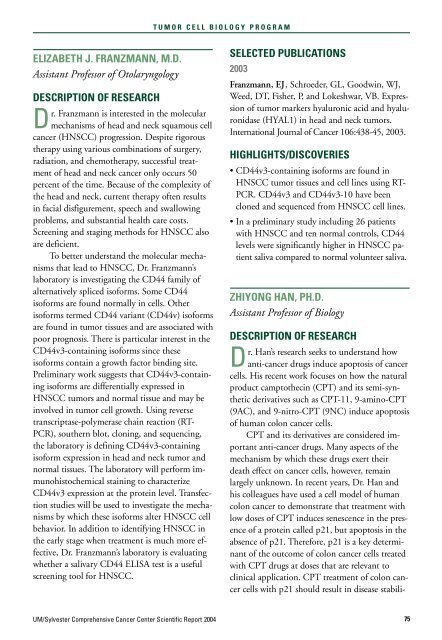SCIENTIFIC REPORT 2004 - Sylvester Comprehensive Cancer Center
SCIENTIFIC REPORT 2004 - Sylvester Comprehensive Cancer Center
SCIENTIFIC REPORT 2004 - Sylvester Comprehensive Cancer Center
Create successful ePaper yourself
Turn your PDF publications into a flip-book with our unique Google optimized e-Paper software.
T U M O R C E L L B I O L O G Y P R O G R A M<br />
ELIZABETH J. FRANZMANN, M.D.<br />
Assistant Professor of Otolaryngology<br />
DESCRIPTION OF RESEARCH<br />
Dr. Franzmann is interested in the molecular<br />
mechanisms of head and neck squamous cell<br />
cancer (HNSCC) progression. Despite rigorous<br />
therapy using various combinations of surgery,<br />
radiation, and chemotherapy, successful treatment<br />
of head and neck cancer only occurs 50<br />
percent of the time. Because of the complexity of<br />
the head and neck, current therapy often results<br />
in facial disfigurement, speech and swallowing<br />
problems, and substantial health care costs.<br />
Screening and staging methods for HNSCC also<br />
are deficient.<br />
To better understand the molecular mechanisms<br />
that lead to HNSCC, Dr. Franzmann’s<br />
laboratory is investigating the CD44 family of<br />
alternatively spliced isoforms. Some CD44<br />
isoforms are found normally in cells. Other<br />
isoforms termed CD44 variant (CD44v) isoforms<br />
are found in tumor tissues and are associated with<br />
poor prognosis. There is particular interest in the<br />
CD44v3-containing isoforms since these<br />
isoforms contain a growth factor binding site.<br />
Preliminary work suggests that CD44v3-containing<br />
isoforms are differentially expressed in<br />
HNSCC tumors and normal tissue and may be<br />
involved in tumor cell growth. Using reverse<br />
transcriptase-polymerase chain reaction (RT-<br />
PCR), southern blot, cloning, and sequencing,<br />
the laboratory is defining CD44v3-containing<br />
isoform expression in head and neck tumor and<br />
normal tissues. The laboratory will perform immunohistochemical<br />
staining to characterize<br />
CD44v3 expression at the protein level. Transfection<br />
studies will be used to investigate the mechanisms<br />
by which these isoforms alter HNSCC cell<br />
behavior. In addition to identifying HNSCC in<br />
the early stage when treatment is much more effective,<br />
Dr. Franzmann’s laboratory is evaluating<br />
whether a salivary CD44 ELISA test is a useful<br />
screening tool for HNSCC.<br />
SELECTED PUBLICATIONS<br />
2003<br />
Franzmann, EJ, Schroeder, GL, Goodwin, WJ,<br />
Weed, DT, Fisher, P, and Lokeshwar, VB. Expression<br />
of tumor markers hyaluronic acid and hyaluronidase<br />
(HYAL1) in head and neck tumors.<br />
International Journal of <strong>Cancer</strong> 106:438-45, 2003.<br />
HIGHLIGHTS/DISCOVERIES<br />
• CD44v3-containing isoforms are found in<br />
HNSCC tumor tissues and cell lines using RT-<br />
PCR. CD44v3 and CD44v3-10 have been<br />
cloned and sequenced from HNSCC cell lines.<br />
• In a preliminary study including 26 patients<br />
with HNSCC and ten normal controls, CD44<br />
levels were significantly higher in HNSCC patient<br />
saliva compared to normal volunteer saliva.<br />
ZHIYONG HAN, PH.D.<br />
Assistant Professor of Biology<br />
DESCRIPTION OF RESEARCH<br />
Dr. Han’s research seeks to understand how<br />
anti-cancer drugs induce apoptosis of cancer<br />
cells. His recent work focuses on how the natural<br />
product camptothecin (CPT) and its semi-synthetic<br />
derivatives such as CPT-11, 9-amino-CPT<br />
(9AC), and 9-nitro-CPT (9NC) induce apoptosis<br />
of human colon cancer cells.<br />
CPT and its derivatives are considered important<br />
anti-cancer drugs. Many aspects of the<br />
mechanism by which these drugs exert their<br />
death effect on cancer cells, however, remain<br />
largely unknown. In recent years, Dr. Han and<br />
his colleagues have used a cell model of human<br />
colon cancer to demonstrate that treatment with<br />
low doses of CPT induces senescence in the presence<br />
of a protein called p21, but apoptosis in the<br />
absence of p21. Therefore, p21 is a key determinant<br />
of the outcome of colon cancer cells treated<br />
with CPT drugs at doses that are relevant to<br />
clinical application. CPT treatment of colon cancer<br />
cells with p21 should result in disease stabili-<br />
UM/<strong>Sylvester</strong> <strong>Comprehensive</strong> <strong>Cancer</strong> <strong>Center</strong> Scientific Report <strong>2004</strong> 75
















